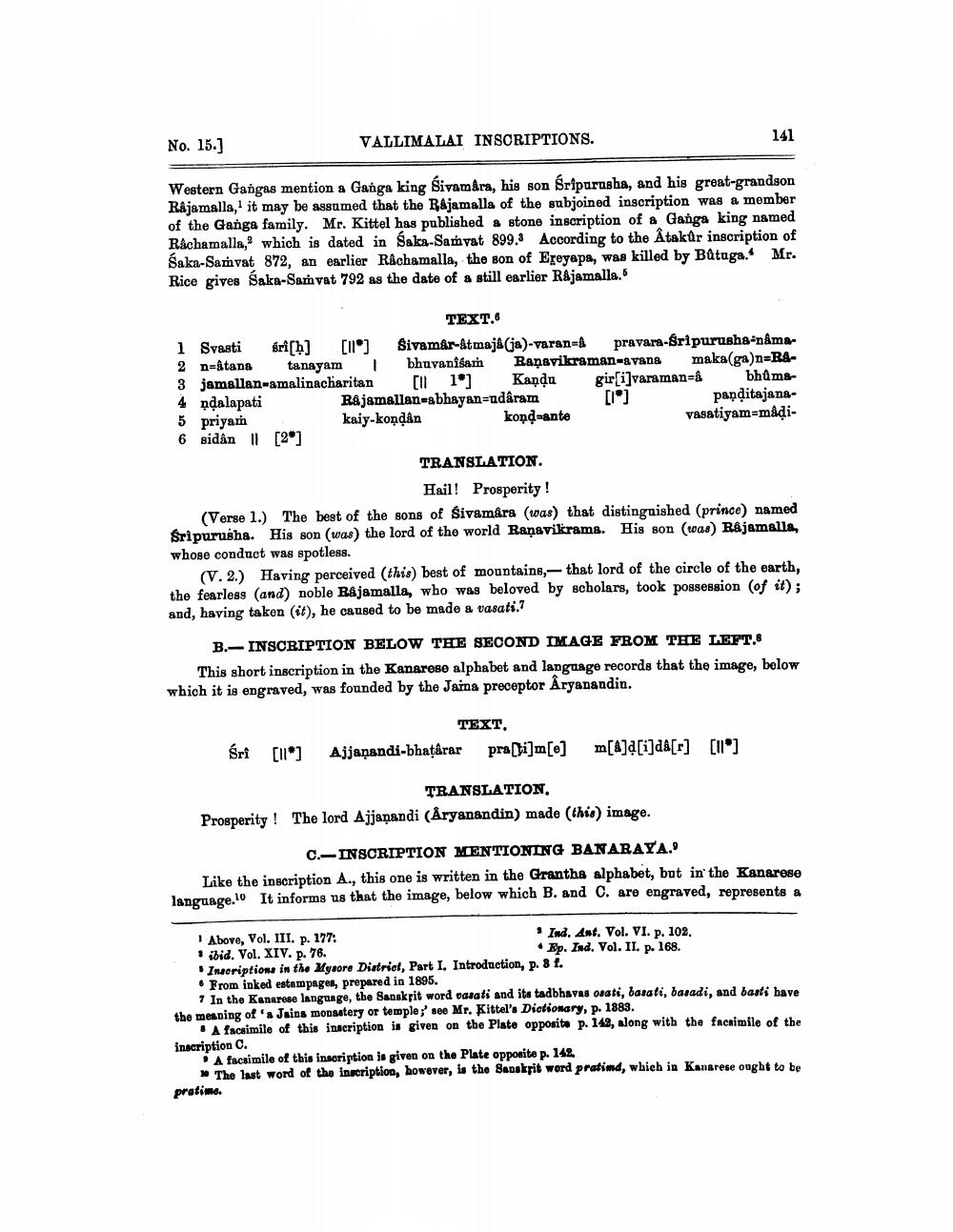________________
No. 15.)
VALLIMALAI INSCRIPTIONS.
141
Western Gangas mention a Ganga king sivamara, his son Sripurusha, and his great-grandson Rajamalla, it may be assumed that the Rajamalla of the subjoined inscription was a member of the Ganga family. Mr. Kittel has published a stone inscription of a Ganga king named Rachamalla, which is dated in Saka-Samyat 899.3 According to the Atakur inscription of Saka-Samvat 872, an earlier Râchamalla, the son of Ereyapa, was killed by Batuga. Mr. Rice gives Saka-Samvat 792 as the date of a still earlier R&jamalla.
TEXT.6 1 Svasti erish] [ll] Sivamär-&tmaja (ja)-varana pravara-Sripurusha-nama2 n=&tans tanayam 1 bhuvanišam Ranavikraman-avana maka(ga)n=R&3 jamallan-amalinacharitan (1) 19) Kaņdu gir[i]varaman bhûma4 ndalapati Rajamallan=abhayan=adâram []
paņditajana5 priyam kaiy-kondân kondeante
vasatiyam=madi6 sidan 11 [2]
TRANSLATION
Hail! Prosperity ! (Verse 1.) The best of the sons of Sivamara (was) that distinguished (prince) named Sripurusha. His son (was the lord of the world Ranavikrama. His son (was) Rajamalla, whose conduct was spotless.
(V. 2.) Having perceived (this) best of mountains, that lord of the circle of the earth, the fearless (and) noble R&jamalla, who was beloved by scholars, took possession (of it); and, having takon (it), he caused to be made a vasati.?
B.- INSCRIPTION BELOW THE SECOND IMAGE FROM THE LEFT.
This short inscription in the Kanarose alphabet and language records that the image, below which it is engraved, was founded by the Jaina preceptor Aryanandin.
TEXT,
Śri
[114]
Ajjaħandi-bhatârar
prasti]m[o]
m[A]a[i]da[r] [ll"]
TRANSLATION, Prosperity! The lord Ajjanandi (Aryanandin) made (this) image.
C.--INSCRIPTION MENTIONING BANARAYA. Like the inscription A., this one is written in the Grantha alphabet, but in the Kanarese language.10 It informs us that the image, below which B. and C. are engraved, represents a
1 Above, Vol. III. p. 177:
Ind. Ant. Vol. VI. p. 102. . ibid. Vol. XIV. p. 76.
• Ep. Ind. Vol. II. p. 168. Inscriptions in the Mysore District, Part I. Introduction, p. 81. . From inked estampages, prepared in 1895.
7 In the Kanarese language, the Sanskrit word parati and its tadbhavas osati, basali, basadi, and basti have the meaning of 'a Jains monastery or temple;' see Mr. Kittel's Dictionary, p. 1883.
• A facsimile of this inscription is given on the Plate opposite p. 142, along with the facaimile of the inscription C.
A facsimile of this inscription is given on the Plate opposite p. 142
* The last word of the inscription, however, is the Sanskrit word pratimd, which in Kanarese ought to be pratims.




